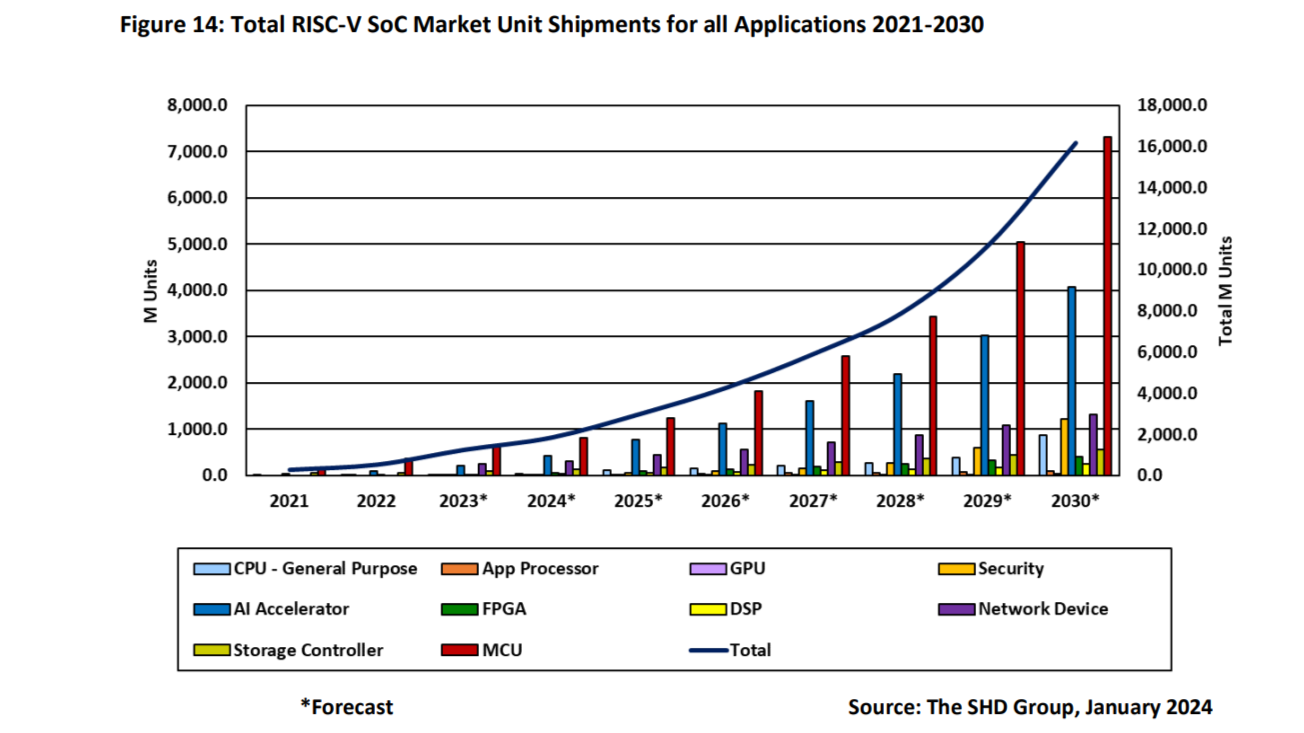- 12 February 2024
- Eleanor Brash
It’s full steam ahead for RISC-V according to a comprehensive report recently released by the SHD Group. Having analysed the potential market for different applications and functions of RISC-V cores over the decade from 2021 to 2030, the author, Rich Wawrzyniak, concludes that 22.3% of all SoCs will include a RISC-V CPU by 2030, generating $92.7 billion in RISC-V revenues.

Understanding the momentum behind the RISC-V movement begins with understanding the increased complexity of today’s SoCs. To achieve the performance that users expect, these SoCs can now field hundreds of different processors to ensure that their various functions are handled in the most efficient way. This heterogeneity is the key to the emergence of RISC-V. Architects are selecting the best CPU for each separate purpose, and this means that increasingly, they are not sourcing all CPUs for an entire SoC from one supplier.
A second driver is the surge in AI. RISC-V’s emergence has corresponded with a shift in processing requirements, where devices now need to include support for popular AI functions such as large language models and generative AI. The subsequent revolution in SoC design has, in turn, lowered barriers for those introducing RISC-V solutions to the table. When hardware designers are already considering alternative solutions, it is a good time for RISC-V to appear at the table.
And as for being fit for purpose, RISC-V cores come with several advantages: without legacy architecture to support each implementation, they can be tailored to a specific application and thereby be lower in area and higher in performance. At the same time, increased competition in the market is introducing new licencing and royalty models.
Sufficient numbers of well-known technology companies have entered the RISC-V arena to remove any doubts in the ecosystem that RISC-V is anything but valuable and here to stay. Among them, the report calls out Imagination as “a force in RISC-V CPU cores” thanks to our involvement in RISC-V International, our GPU IP’s compatibility with RISC-V-based SoCs, and our commitment to our RISC-V CPU roadmap. This starts with the already available and licenced real-time embedded IMG RTXM-2200 and moves on to high-performance application CPUs and functionally safe automotive CPUs.
RTXM-2200 is a 32-bit processor that is suitable for several different applications: network processing, security enclaves, helper cores, and storage controllers. The latter is predicted to be the third most popular RISC-V part type, shipping around 558M RISC-V units by 2030.

In 2024, there are a number of key things the RISC-V industry needs to do in order to capitalise on the rapid market adoption that the report predicts. Firstly, the industry needs to continue to introduce high-quality cores to the market so that hardware designers looking for alternative CPU solutions for their SoC can find a right-shape RISC-V alternative. Secondly, the industry must persist in accelerating the development of the RISC-V software ecosystem, including EDA tools, such that any potential RISC-V customer can have faith that previous investments in software can be ported to the new architecture. Central to this project is the RISE initiative, a collaborative effort led by industry leaders, including Imagination, to develop open source software for the RISC-V architecture.
To find out more about Imagination’s RISC-V roadmap for 2024 and beyond, book a meeting with our sales team.






